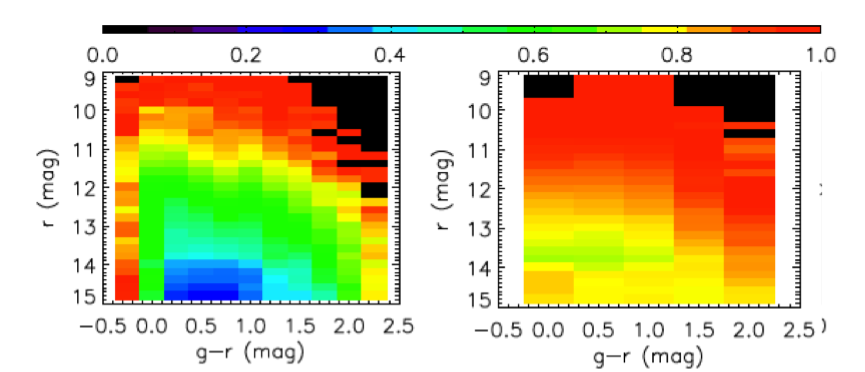中国西南天文研究所研究团组对LAMOST巡天选择效应研究取得新进展
The selection function of the LAMOST Spectroscopic Survey of the Galactic Anticentre
近日,云南大学中国西南天文研究所陈丙秋副教授和刘晓为教授等人详细分析了LAMOST光谱巡天的选择效应,给出了LAMOST星表的选择函数。
LAMOST等大型银河系光谱巡天项目为天文学家提供了银河系海量恒星视向速度、物理化学参数及年龄等信息,为研究银河系的结构和物质组成、恒星形成和化学增丰历史,约束银河系的形成和演化理论及模型提供了重要的依据。然而,不同于成像测光巡天,受制于现有的观测能力,光谱巡天只能对视场中有限的源进行观测,且获取的光谱质量参差不齐,最终得到的分光样本是有偏的。因此,精确地改正样本的选择效应,把光谱巡天得到的恒星样本在多维可测量参数相空间中的分布转化为恒星在该多维相空间里的真实分布,对实现LAMOST巡天的核心科学目标至关重要。
虽然LAMOST是当今世界上光谱获取率最高的光谱巡天望远镜,其对银河系恒星的采样依然是远远不够完备的,因此基于其星表的科学工作都需要考虑并做选择效应改正。云南大学中国西南天文研究所近场宇宙学研究团组详细研究了LAMOST反银心方向光谱巡天的选择效应。基于盱眙反银心方向测光巡天以及APASS数据,综合考虑了LSS-GAC的选源条件以及不同观测条件、不同摄谱仪观测效率、参数测量流水线带来的选择效应,给出了LSS-GAC增值星表中每颗恒星的选择函数,为后续研究工作奠定了基础。该研究工作已被《皇家天文学月刊》(Monthly Notices of the Royal Astronomical Society)接受,将于近期发表(预印本文库链接https://arxiv.org/abs/ 1802.06777)。

图. 不同因素导致的LAMOST反银心方向光谱巡天选择效应在颜色星等图上的分布图。左图:由LSS-GAC的选源条件引起的选择效应;右图:由观测条件、光谱质量以及参数流水线导致的选择效应 。Colour-magnitude distribution of the selection effects of LSS-GAC as caused by: a) the target selection algorithms (left); and b) the observational conditions, data quality and parameter determination pipeline (right).

Large-scale spectroscopic surveys of Galactic stars such as the LAMOST Spectroscopic Survey of the Galactic Anticentre (LSS-GAC), are opening a new window for the study of the formation and evolution of the Milky Way galaxy in great detail. However, unlike photometric surveys that yield, in general, complete samples of objects to a given limiting magnitude, time consuming spectroscopic surveys often have to select targets, and are unavoidably affected by various selection effects. The biases may arise from the target selection algorithms, the quality of the observational data, the data reduction processes and the extraction of stellar parameters from the data. To understand the relationship between spectroscopic sample of stars with reliable stellar parameter estimates and the underlying stellar populations, one needs to determine and account for the selection function of the spectroscopic survey.
We present a detailed analysis of the selection function of LSS-GAC. In this study, we show how the selection function can be evaluated to a sufficient accuracy and derive the selection function corrections for all spectroscopic targets with robust parameter estimates. The results, to be released as new entries in the LSS-GAC value-added catalogues, can be used to correct the selection effects of the catalogues for scientific studies of various purposes. The paper has been accepted for publication in the Monthly Notices of the Royal Astronomical Society (arXiv link: https://arxiv.org/abs/1802.06777).
